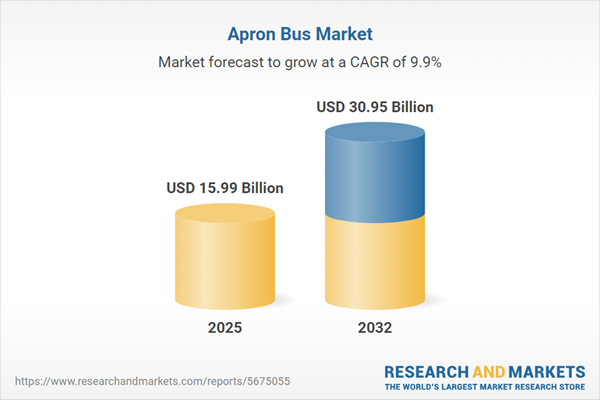Speak directly to the analyst to clarify any post sales queries you may have.
The apron bus market is undergoing rapid transformation, driven by technological innovation, evolving regulatory frameworks, and heightened demands for operational efficiency and sustainability. As airports and airlines adapt to new mobility challenges, strategic investments in advanced propulsion systems and digital tools are reshaping ground transportation ecosystems worldwide.
Market Snapshot: Apron Bus Market Size and Growth
The apron bus market grew from USD 14.51 billion in 2024 to USD 15.99 billion in 2025. It is expected to expand further at a CAGR of 9.92%, reaching USD 30.95 billion by 2032.
Scope & Segmentation
This report provides a comprehensive view of the apron bus sector, analyzing its core segments, innovative technologies, and global reach.
- Propulsion Types: Compressed Natural Gas, Liquefied Natural Gas, Conventional Diesel, Ultra-Low Sulfur Diesel, Battery Electric (Lithium-Ion, Solid-State), Fuel Cell Electric (PEMFC, SOFC), Parallel Hybrid, Series Hybrid
- Bus Types: Articulated, Double-Decker, High-Floor, Low-Floor
- Capacity Ranges: Up To 25 Seats, 26-40 Seats, 41-60 Seats, Above 60 Seats
- Applications: Airport Shuttle (Fixed-Route, On-Demand), City Transit (Express, Standard), Intercity, Tourism
- Sales Channels: OEM, Aftermarket (Parts, Services)
- Regional Coverage: Americas (North America: United States, Canada, Mexico; Latin America: Brazil, Argentina, Chile, Colombia, Peru), Europe, Middle East & Africa (United Kingdom, Germany, France, Russia, Italy, Spain, Netherlands, Sweden, Poland, Switzerland, United Arab Emirates, Saudi Arabia, Qatar, Turkey, Israel, South Africa, Nigeria, Egypt, Kenya), Asia-Pacific (China, India, Japan, Australia, South Korea, Indonesia, Thailand, Malaysia, Singapore, Taiwan)
- Industry Participants: Swissport International AG, Menzies Aviation Group Limited, dnata LLC, SATS Ltd, Worldwide Flight Services SA, Celebi Aviation Holding A.S., Aviator Airport Alliance UK Ltd, China National Aviation Ground Operations Corporation, Japan Airport Terminal Co., Ltd., Lufthansa Airport Services GmbH
Key Takeaways
- Apron bus fleets are moving toward electrification and hybrid powertrains, supporting sustainability targets amid stricter environmental regulations worldwide.
- Advanced telematics, predictive maintenance, and connected vehicle systems are improving reliability, enabling optimized route planning, and enhancing passenger safety.
- Regional differences in infrastructure maturity and policy support drive distinct adoption patterns, with electric solutions rising in major airport hubs and traditional diesel remaining relevant in emerging markets.
- Strategic partnerships among OEMs, airports, and component suppliers are accelerating the real-world deployment of new propulsion technologies and digital platforms.
- Segment diversification—including a wide range of capacities and vehicle configurations—enables tailored solutions for differing airport layouts and passenger demands.
- Aftermarket services are creating value through bundled maintenance and parts contracts, helping operators manage cost and asset life-cycle reliability.
Tariff Impact
Planned 2025 U.S. tariff adjustments will affect apron bus supply chains globally. Companies are reassessing sourcing strategies, investing in nearshoring solutions, and localizing production for key components to safeguard margins and reduce lead times. Tier-one manufacturers are pursuing joint ventures and licensing to gain tariff-exempt status, driving the market toward a mix of localized and imported technologies. These shifts reinforce the importance of agile procurement and regional manufacturing in securing resilient modernization strategies.
Methodology & Data Sources
The research adopts a multi-stage approach, combining in-depth interviews with senior executives from OEMs, airport authorities, and suppliers, with rigorous analysis of secondary data. Findings reflect qualitative insights and quantitative benchmarking, thoroughly validated through data triangulation, expert panels, and scenario modeling.
Why This Report Matters
- Enables senior decision-makers to align investment priorities with fast-evolving technological and policy trends.
- Provides actionable intelligence for optimizing fleet composition, procurement, and maintenance strategies in a changing market environment.
- Reveals regional variances and emerging value pools, supporting targeted business development and risk mitigation.
Conclusion
This report offers clear guidance for navigating the dynamic apron bus market, empowering leaders to make informed decisions, capture growth opportunities, and drive operational excellence in airport ground transportation.
Additional Product Information:
- Purchase of this report includes 1 year online access with quarterly updates.
- This report can be updated on request. Please contact our Customer Experience team using the Ask a Question widget on our website.
Table of Contents
3. Executive Summary
4. Market Overview
7. Cumulative Impact of Artificial Intelligence 2025
Companies Mentioned
The companies profiled in this Apron Bus market report include:- Swissport International AG
- Menzies Aviation Group Limited
- dnata LLC
- SATS Ltd
- Worldwide Flight Services SA
- Celebi Aviation Holding A.S.
- Aviator Airport Alliance UK Ltd
- China National Aviation Ground Operations Corporation
- Japan Airport Terminal Co., Ltd.
- Lufthansa Airport Services GmbH
Table Information
| Report Attribute | Details |
|---|---|
| No. of Pages | 188 |
| Published | October 2025 |
| Forecast Period | 2025 - 2032 |
| Estimated Market Value ( USD | $ 15.99 Billion |
| Forecasted Market Value ( USD | $ 30.95 Billion |
| Compound Annual Growth Rate | 9.9% |
| Regions Covered | Global |
| No. of Companies Mentioned | 11 |









